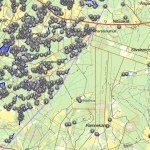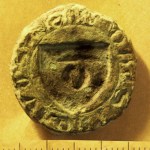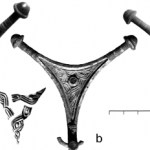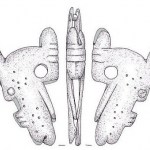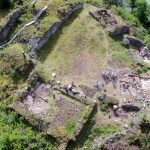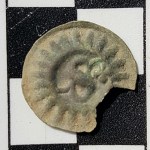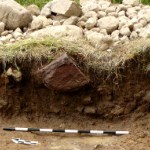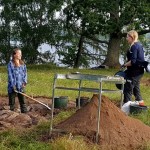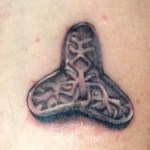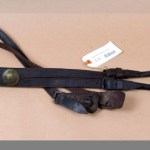archaeology
The Swedish national register of archaeological sites is one of the best in the world. But if you ever consider using it for any kind of research purpose, have a look first at the register's map of sites just west of Örkelljunga in Scania. The diagonal line is the parish boundary between Tåssjö and Rya. Tåssjö has undergone intensive survey for forest sites, most of which derive from Early Modern resource extraction. Rya has not.
For the first time since 2011 I haven't got any teaching this autumn semester, which is really bad both for my finances and for my troop morale. (I feel like my colleagues would celebrate or not even notice if I got eaten by a grue tomorrow.) To boost both I'm instead seeking paid extramural speaking gigs. Here's what I've got scheduled at the moment.
27 Sept. On early local history, in Sickla.
6 Oct. On the Skällvik castle excavation, in Söderköping.
19 Oct. On archaeology and religion, in Jönköping.
20 Oct. On archaeology and religion, in Visby.
27 Oct. On archaeology and religion, in…
My detectorist friend and long-time collaborator Svante Tibell found a seal matrix in the field next to Skällvik Castle this past summer. In the Middle Ages of Sweden, people of means didn't sign their names to documents. They carried seals around, with which they made imprints into chalk-mixed wax, and these were affixed to paperwork such as property deeds and wills. If you lost your seal matrix, you lost your ability to sign documents – and you theoretically gave that ability to whoever found your seal. When people died during this period, their seal matrices were carefully destroyed.…
From 2014 on, Swedish metal detectorists have had to report all finds datable to before 1850 to the authorities. I have recently shown in a note in Fornvännen that this rule came about by mistake, and that it has broken the County Archaeologist system. It takes hours for a county heritage administrator to process one metal detector permit. It also takes only a few hours for a detectorist to find a copper coin from the 1840s, which voids her/his permit for that site. S/he then applies for a new permit, which means that the pile of unprocessed permit applications on each administrator's…
This is a great cartoon by Randall Munroe that makes a very important point very effectively. Spread it around, love it, learn from it.
Here is an excellent video walkthrough of the cartoon, discussing its value as a communication tool.
But do ignore the details of the prehistory because the cartoonist has fallen into the same trap so many others have, well meaning in intention but simply a) not an expert on key things and b) unaware of the real consequences of getting certain things wrong.
When we represent prehistory, we represent humanity both past and present. It is not difficult to do…
In December of last year I finished a collection of short humorous archaeological essays. It's my sixth book, my first one in Swedish, my first one aimed at the lay reader. Since then I've been waiting for established Swedish publishing houses to pronounce judgement on it. Five of them have now turned it down, none with any very detailed explanation, but most of them in terms suggesting that they think it's competently written but it probably wouldn't sell much.
As a long-time blogger and e-book reader, I am not particularly disheartened by this. After all, this blog has a greater number of…
Dress pin heads from Viidumäe on Saaremaa.
Fornvännen 2015:4 is now on-line on Open Access.
Therese Ekholm compares radiocarbon dates on bone versus charcoal from ostensibly closed contexts on Stone Age sites in northern Sweden.
Tony Björk & Ylva Wickberg on continued investigations of the Degeberga linear monument in Scania.
Indrek Jets & Marika Mägi on a Viking Period sacrificial site at Viidumäe on Saaremaa that's been robbed by nighthawk detectorists.
Pål Ulseth et al. on technical waste from the Medieval mint in Trondheim.
Tom H. Borse Haraldsen challenges Arne Espelund'…
Here's a guest entry by my correspondent Ben Bishop who's doing a project on Medieval scabbard mounts using data from the Portable Antiquites Scheme (PAS).
-----
I am researching medieval English scabbard chapes formed of folded copper alloy. They date from the period c. AD 1050–1300. The overwhelming majority are fragmentary when found and recognisable by the most decorative elements (shield for the mounted warrior, dragon head for the winged dragon). They are spread across England, including the Isle of Wight. The counties that are richest in these objects are Wiltshire (particularly L…
Several colleagues have told me this bizarre rumour that I hope is unfounded. Contract archaeologists at two sites on Öland and in Småland have found more Medieval coins than their conservation budget can cover. So they have to prioritise which coins to conserve. So far so good, and congrats on the lovely finds.
But.
According to this rumour, someone in an official position is demanding that they throw away the coins they choose not to conserve. Because there is no place in this person's administrative framework for unconserved finds from a contract excavation.
Is this true!?…
Detectorist John Kvanli is the chairman of Rygene detektorklubb and one of Norway's most prominent proponents of collaboration between amateurs and professionals in field archaeology. Of course he has a tattoo! It's an Urnes brooch from c. AD 1100, in the final exquisite Christian style of Scandinavian animal art.
John tells me he has found several fragments of these fragile objects, but the one inked onto his upper right arm is a settlement excavation find from Lindholm Høje, across the fjord from Aalborg in northern Jutland. The needlework was done by the Martin Tattoo Studio in Bangkok,…
Our second week at Skällvik Castle proved a continued small-finds bonanza, and we also documented some pretty interesting stratigraphy.
More of everything in Building IV. In addition to more coins of Magnus Eriksson, dice and stoneware drinking vessels, we also found a lot of points for crossbow bolts. It's starting to look like the castle guards' day room! As for why we found crossbow bolts only inside one building and none outdoors in the bailey, I figure that they had been amassed there for re-fletching. The dark indoors find context and the undamaged sharp points show that the bolts did…
The famous royal castle of Stegeborg sits on its island like a cork in the bottleneck of the Slätbaken inlet (see map here). This waterway leads straight to Söderköping, a major Medieval town, and to the mouth of River Storån which would allow an invader to penetrate far into Östergötland Province's plains belt. The area's first big piece of public construction was 9th century fortifications intended to guard this entrypoint, in the shape of the Götavirke earthen rampart some ways inland and a wooden barrage at Stegeborg. This barrage was kept up for centuries, and indeed, the castle's name…
We spent Thursday afternoon backfilling. As I write this, only trench G remains open, and the guys there expect to finish soon. Here's some highlights of what we've learned during our second week at Birgittas udde.
Trench A in the outer moat demonstrated that the moat had a wide flat bottom, was not very deep and contains no lake sediments. Probably always a dry moat, providing material for the bank behind it. No Medieval finds.
Trench C: section through the deep inner moat.
Trench C in the inner moat demonstrated that this moat too had a wide flat bottom, but it was deeper and is full of…
Ulvåsa in Ekebyborna is a manor near Motala with two known major Medieval elite settlement sites. Excavations in 2002 proved that the unfortified Gamlegården site was established before AD 1100. The fortified Birgittas udde site has seen no archaeological fieldwork since 1924, when the main building's cellar was emptied and restored. Its date is only known to the extent that almost all moated sites of this kind in Sweden belong to the period 1250-1500. My current book project deals with Östergötland province's fortified sites of the High/Late Middle Ages, and so I decided to spend two weeks…
René Lund Klee's tattoo
In our series of metal detectorist tattoos, where people put pictures of their best finds on themselves -- usually on their detector arms -- we now pay a visit to René Lund Klee. His tattoo depicts an Urnes brooch that he found on the Danish island of Lolland. The needlework was done there by Sandra's Ink in Nakskov.
Urnes brooch from Lolland
The Urnes style of c. AD 1050-1125 forms the end of the Scandinavian animal art tradition, which produced astonishing artistic riches during the Late Iron Age (c. 375-1125). Named for a Norwegian wooden church from the 1070s…
Jan Mortensen's tattoo
Another metal detectorist tattoo! This time it's Jan Mortensen who has decorated the arm with which he brandishes the detector. The object is a 10th century trefoil brooch that Jan found in Holbæk municipality, northern Zealand. Hugo Tattoo in Holbæk did the needlework.
Trefoil brooches were worn by South Scandinavian women as a third brooch, to close their cloaks. But the overall shape descended from high-end acanthus-decorated silver mounts for the bandoliers worn by Charlemagne's vassals around AD 800. Their trefoils joined the strap from the scabbard to the…
As I blogged about in late May, a recent find from Blekinge has cast light on an enigmatic oval mount that my team collected in Östergötland in 2007. We can now say fairly confidently that the object type belongs to the 19th century. And yesterday Karin Tetteris of the Swedish Army Museum came through with evidence that strengthens this dating and suggests a function for the mounts: horse harness.
Specifically, we're dealing with cruppers, Sw. svanskappor, "a soft padded loop under the base of the tail, to keep the harness from slipping forward" as Wikipedia explains. None of the mounts in…
Toby Martin 2015, The Cruciform Brooch and Anglo-Saxon England
Back around Christmas I reviewed the first three chapters of Toby Martin's big book about Anglo-Saxon cruciform brooches. Those are the technical chapters dealing with typology and chronology, and I loved them. They are rock solid. Now I've read the remaining four chapters that deal with the societal interpretation of the brooches. In the following I am going to use the author's given name because Martin is me.
I think Toby's investigations and interpretations here are excellent. I particularly like his painstaking study of how…
I've linked before to Christina Fredengren's ground-breaking paper in Fornvännen 2015:3 about human and animal remains found in wet contexts in Uppland province (the area around Uppsala). The study's empirical base is solid and eye-opening. I don't find find the theoretical superstructure that the author briefly sketches onto it (the titular ”water politics”) convincing. But that's not my main complaint about this otherwise excellent piece of research.
Look at the map above, covering a small part of the study area. Bear in mind that due to the relieved pressure of the inland ice,…
Myself, Ethan Aines and Mats G. Eriksson are proud to present our report on last year’s fieldwork at Stensö Castle, Östra Husby parish, Östergötland. Lots of goodies there, and with an added meaty report on the bones by Rudolf Gustavsson! It was a very fruitful two weeks at the site, during which we found the missing half of the perimeter wall, abundant fine pottery from around AD 1300, a runic inscription by a certain Helgi, the bones of a skinned cat, and more.
Here on Sb: Stenso 2015 Report (High-res, single-sided print)
And on archive.org.
See also the report for…
